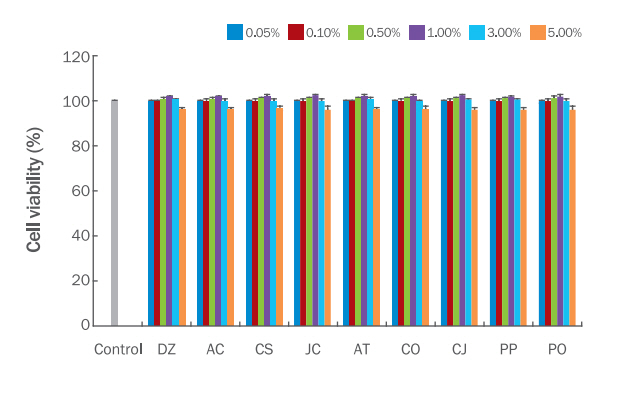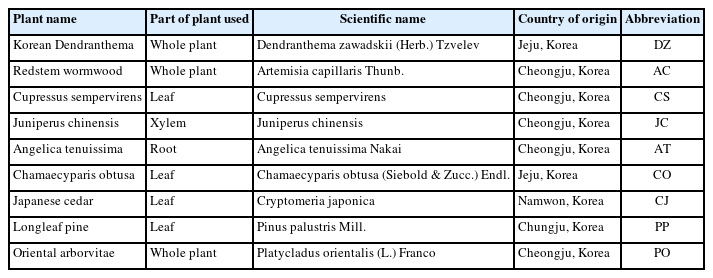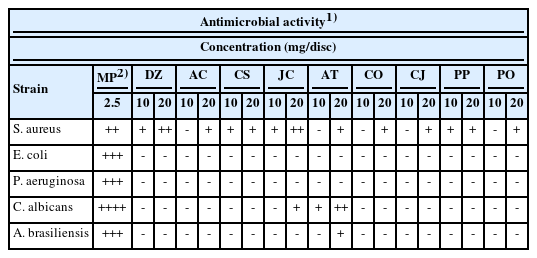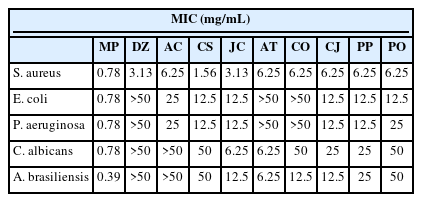피톤치드 추출물의 항균 및 항산화 활성에 대한 연구
A Study on the Antimicrobial and Antioxidant Activity of Phytoncide Extract
植物杀菌素提取物抗菌和抗氧化活性的研究
Article information
Abstract
목적
본 연구에서는 피톤치드 추출물 9종의 세포독성, 항산화력, 항균력의 생리활성을 규명하여 화장품 소재로서의 활용 가능성을 연구하였다.
방법
피톤치드 추출물과 관련된 천연물 9종을 선정한 후 추출하여 시료로 사용하였다. MTT assay를 통하여 안전성을 확인하였으며, DPPH radical 소거 활성 평가를 통한 항산화 효능과 disc diffusion assay, minimum inhibitory concentration (MIC) 및 minimum bactericidal concentration (MBC)를 통한 항균 효과를 평가하였다.
결과
피톤치드 추출물 9종 모두 3.00% 이하의 농도에서 fibroblast의 세포 독성에 대한 안전성을 확인하였다. 모든 피톤치드 추출물에서 DPPH radical 소거능력이 유사하였으며, 항산화 효능이 있음을 확인하였다. 항균 효능은 전체적으로 그람 음성균과 진균에 대해서는 강한 항균활성을 나타내지 못했으나, 그람 양성균에서 우수한 항균활성을 보였다. 산구절초추출물과 솔잣나무추출물은 그람 양성균에서만 항균 활성을 나타냈고, 향나무목부추출물은 그람 양성균과 효모에 대하여 우수한 항균 활성을 보였으며, 고본뿌리추출물은 세균보다는 진균에서 높은 항균 활성을 나타냈다.
결론
이상의 연구 결과를 바탕으로 3.00% 이하의 농도에서 산구절초추출물, 솔잣나무추출물, 향나무목부추출물, 고본뿌리추출물에서 우수한 항균 및 항산화 효능을 확인하였으며, 합성 방부제나 항산화제를 대체하는 천연 성분의 화장품 소재로써 활용 가능성이 높을 것으로 판단된다.
Trans Abstract
Purpose
This study aims to confirm the physiological activity of cytotoxicity, antioxidant effects, and antibacterial effects of 9 kinds phytoncide extracts were investigated and the possibility of their application as cosmetic materials was studied.
Methods
The 9 kinds natural products related to phytoncide extract were selected, extracted, and used as samples. Safety was confirmed through MTT assay, and antioxidant effect through DPPH radical scavenging activity evaluation and antibacterial effect through disc diffusion assay, minimum inhibitory concentration (MIC), and minimum bacteriological concentration (MBC) were evaluated.
Results
All 9 kinds phytoncide extracts were confirmed to be safe against Fibroblast cytotoxicity at a concentration of 3.00% or less. The DPPH radical scavenging ability was similar in all phytoncide extracts, and it was confirmed that there was an antioxidant effect. The antibacterial effect did not show strong antibacterial activity against gram-negative bacteria, yeast and fungi as a whole, but it showed excellent antibacterial activity against gram-positive bacteria. Dendranthema zawadskii (Herb.) Tzvelev, Cupressus sempervirens showed antibacterial activity only on gram-positive bacteria. Juniperus chinensis showed excellent antibacterial activity against gram-positive bacteria, yeast. Angelica tenuissima Nakai showed high antibacterial activity against fungi rather than bacteria.
Conclusion
These results show that excellent antibacterial and antioxidant effects were confirmed in Dendranthema zawadskii (Herb.) Tzvelev, Cupressus sempervirens, Juniperus chinensis and Angelica tenuissima Nakai at a concentration of 3.00% or less. It is judged that highly likely to be use as a cosmetic material with natural ingredients that replace synthetic preservatives or antioxidants.
Trans Abstract
目的
确定9种植物杀菌素提取物的细胞毒性、抗氧化作用和抗菌作用等生理活性,并研究其作为化妆品原料应用的可能性。
方法
选取9种与植物杀菌素提取物有关的天然产物,进行提取,作为样品。通过MTT测定确认安全性,通过DPPH自由基清除活性评价抗氧化效果,通过纸片扩散测定、最低抑菌浓度(MIC)和最低细菌学浓度(MBC)评价抗菌效果。
结果
所有9种植物杀菌素提取物在3.00%或更低的浓度下均被证实对成纤维细胞的细胞毒性是安全的。所有植物杀菌素提取物的DPPH自由基清除能力相似,证实具有抗氧化作用。抗菌作用对革兰氏阴性菌、酵母菌和真菌整体没有表现出较强的抗菌活性,但对革兰氏阳性菌表现出极好的抗菌活性。Dendranthema zawadskii (Herb.) Tzvelev,Cupressus sempervirens 仅对革兰氏阳性菌表现出抗菌活性。杜松对革兰氏阳性菌和酵母菌表现出优异的抗菌活性。当归对真菌而非细菌表现出高抗菌活性。
结论
这些结果表明,Dendranthema zawadskii (Herb.) Tzvelev、Cupressus sempervirens、Juniperus chinensis 和Angelica tenuissima Nakai在浓度为3.00%或更低时具有出色的抗菌和抗氧化作用。据判断,极有可能用作含有天然成分的化妆品材料,以替代合成防腐剂或抗氧化剂。
Introduction
식물은 해충이나 미생물로부터 자기를 방어하거나, 다른 식물의 생장을 억제하는 타감작용(allelopathy)의 과정에서 휘발성의 다양한 천연 항균물질을 생성 및 발산하며, 이를 일반적으로 피톤치드(phytoncide)라고 명명한다(Muller, 1969). 피톤치드는 식물(phyton)이라는 뜻을 가진 그리스어와 죽이다(cide)를 뜻하는 라틴어의 합성어로서 식물이 만들어내는 살균작용을 가진 휘발성, 비휘발성 화합물을 총칭하는 말이다(Kim et al., 2006). 피톤치드는 식물의 성장과 분화에 직접적인 영향을 미치지 않으나 항산화, 항염증, 살균, 신경 안정 등에 뛰어난 효과를 나타내는 것으로 보고되었다(Cheng et al., 2009; Fujimori et al., 2009; Thangaleela et al., 2022). 또한, 모든 식물이 피톤치드를 생성하지만 잣나무, 편백나무, 소나무와 같은 침엽수 또는 쑥, 구절초와 같은 자생식물에서 많이 함유되어 있는 것으로 알려져 있다(Kim et al., 2020; Kurkina et al., 2020). 피톤치드의 대표적인 성분으로는 테르펜(Terpene)계 물질이며, 이외에도 알칼로이드, 배당체, 플라보노이드와 같은 페놀성 성분과 기타 비휘발성 성분 등 다양한 성분으로 구성되어 있다(Whittaker & Feeny, 1971).
테르펜은 식물세포의 대사산물이며 에센셜 오일과 수지의 주요 성분이다(Omar et al., 2016; Allenspach & Steuer, 2021). 그 중에서 모노테르펜(monoterpaene, C10H16)과 세스퀴테르펜(sesquiterpene, C15H24)이 대부분을 차지하고(Zorić et al., 2020; Kim et al., 2022), 특히 모노테르펜 계열인 알파-피넨(α-Pinene)은 피톤치드의 주요 천연 항생물질로 미생물의 세포 표면에 흡착하여 세포막을 교란 및 파괴함으로써 항균 효과가 있는 것으로 보고되었다(Dhar et al., 2014; Li et al., 2006). 또한, 진정 작용효과와 수면 개선 효과가 있으며(Kawakami et al., 2004; Yang et al., 2016), 그 외에도 고혈압, 항염증 효과가 있다고 알려져 있다(Orhan et al., 2006).
식물로부터 피톤치드를 추출할 수 있는 방법으로는 수증기 증류(steam distillation), 압착(expression), 추출(extraction)방법 등으로 나누어져 있다. 이 중 추출방법은 추출용매에 따라 유지 흡수법(fat adsorption)과 휘발성 유기용제 추출법(organic solvent extraction), 초임계유체 추출법(supercritical fluid extraction, SFE) 등으로 나뉘며 추출하는 방법에 따라 장단점이 존재한다. 주로 식물 정유 추출에 널리 이용하는 방법으로는 비교적 높은 수율을 보장하는 휘발성 유기용제 추출법을 적용하여 사용되고 있다(Kim & Lee, 2015; Kim & Kim, 2010; Kim et al., 2019).
화장품은 물, 오일, 왁스 등의 미생물이 증식하기 쉬운 조건으로 구성되어 있으며, 사용 방법 및 보관 방법에 있어서도 미생물로부터 오염되기 쉬운 환경이다. 이러한 이유로 화장품에는 방부제의 사용이 필수적이며 주로 사용되고 있는 방부제는 파라벤류, 페녹시에탄올, 이미다졸리디닐 우레아 등 합성 방부제에 의존하고 있다(Lundov et al., 2011). 합성 방부제는 피부 자극, 알러지 반응 및 내분비계 교란 등와 같은 부작용 사례가 많이 발생하고 있다(Darbre et al., 2004). 합성 방부제를 대체하기 위하여 천연 항균 소재에 대한 소비자의 요구가 높아지고 있으며 끊임없는 연구가 진행되고 있다(Lee & Ahn, 2022).
본 연구에서는 국내에서 자생하고 있으며 피톤치드의 대표적인 테르펜(Terpene)계 성분 중 알파-피넨 성분의 함량이 높은 천연물 9종으로 편백잎(Chamaecyparis obtusa (Siebold & Zucc.) Endl.), 측백나무(Platycladus orientalis (L.) Franco), 대왕송잎(Pinus palustris Mill.), 삼나무잎(Cryptomeria japonica), 향나무목부Juniperus chinensis), 사철쑥(Artemisia capillaris Thunb.), 산구절초(Dendranthema zawadskii (Herb.) Tzvelev), 고본뿌리(Angelica tenuissima Nakai), 솔잣나무잎(Cupressus sempervirens)을 선정하였다(Cheng et al., 2009; Kim, 2017; Jo & Kim, 2004; Kim & Chi, 1989; Kim et al., 1998; Khamis & Chai, 2021; Kurose et al., 2007; Moon & Yoo, 2005). 각 천연물은 휘발성 용매추출 방법을 적용하여 추출하였고, 화장품 오염의 주요 원인이 되는 균주를 대상으로 항균효과 및 항산화 작용을 비교 실험하여 천연 성분으로써 합성 방부제나 항산화제의 대체 가능성을 확인하고자 하였다.
Method
1. 시료의 준비
본 실험에 사용된 자생식물 9종은 ㈜단정바이오에서 제공받아 사용하였다(Table 1). 자생식물 9종은 자연 건조한 후 세절하였고, 시료 25 g에 30% 에탄올 1 L를 넣고, 4 h 동안 60-90℃에서 3회 환류추출하여 실온에서 냉침하였다. 각각의 시료 추출물은 여과지(Whatman #3, UK)로 여과하였고, 50℃ 이하에서 감압농축 및 동결 건조하여 -20℃의 냉동고에 보관하면서 사용하였다.
2. 사용 균주 및 배지
실험에 사용된 균주는 '화장품 방부력 평가법(ISO11930)'에 제시된 방부 시험 균주인 그람 양성균 Staphylococcus aureus (S. aureus; ATCC6538)와 그람 음성균 Escherichia coli (E. coli; ATCC8739), Pseudomonas aeruginosa (P. aeruginosa; ATCC9027), 효모 Candida albicans (C. albicans; ATCC10231)와 진균 Aspergillus brasiliensis (A. brasiliensis; ATCC16404)로 총 5종의 균주를 선정하였으며, American Type Culture Collection (ATCC; USA)에서 분양 받아 사용하였다. 각 균주의 배양배지 및 배양조건은 Table 2에 나타내었다. 균주 활성화 및 배양에 사용한 배지는 Difco (USA)사의 제품을 사용하였다.
3. 세포 독성 측정
3-(4,5-dimethythiazol-2-yl)-2,5-diphenyl tetrazolium bromide (MTT) assay를 이용하여 측정하였다. 10% bovine calf serum (BCS; Gibco, USA)가 첨가된 Dulbecco's modified eagle medium (DMEM; Gibco) 배지를 이용하여 세포주 NIH 3T3 cell (ATCC, CRL-1658)를 96 well plate에 5.0×103 cells/well의 농도로 분주하고 37℃, 5% CO2 incubator에서 24 h 배양하였다. BCS를 첨가하지 않은 배지로 교체하여 시료를 농도별(0.05, 0.10, 1.00, 3.00, 5.00%)로 첨가하고 24 h 배양한 뒤, MTT (Gibco)용액을 1 μg/mL의 농도로 가하여 37℃에서 3 h 반응시켰다. 미반응된 MTT 용액을 제거하고 dimethyl sulfoxide (DMSO; Sigma, USA) 100 μL를 가해 형성된 반응물을 용해시킨 후, ELISA plate reader를 이용하여 540 nm에서 측정해 시료의 세포독성을 확인하였다. 세포 생존율 실험은 3회 반복 진행하였으며, 다음과 같이 계산하였다.
Cell viability (%)=[(시료 첨가군의 흡광도-대조군의 흡광도)/(대조군의 흡광도)]×100
4. DPPH radical 소거능 측정
추출물에 대한 항산화 활성을 확인하기 위한 방법으로 2,2-diphenyl-1-picrylhydrazyl (DPPH) radical 소거능을 측정하였다. DPPH (Sigma)를 이용한 항산화 활성은 Blois의 방법을 변형하여 시험을 수행하였다(Blois, 1985). 메탄올에 농도별(0.05, 0.10, 0.50, 1.00, 3.00%)로 희석한 시료를 96-well plate에 20 μL씩 분주한 후 0.2 mM DPPH 용액 180 μL를 첨가한다. 37℃에서 15 min 동안 암실에서 반응시킨 후 ELISA reader (Versamax; Molecular devices, USA)를 이용하여 517 nm에서 흡광도를 측정하였다. 활성 비교를 위해 양성대조군은 ascorbic acid (Sigma)를 사용하였다. DPPH radical 소거능 계산은 대조군과 흡광도 차이를 비교하여 free radical의 제거 활성을 백분율로 나타내었다.
DPPH radicals scavenging activity (%)=100-[(시료 첨가군의 흡광도)/(대조군의 흡광도)×100]
5. 항균 활성 측정
각 추출물에 대한 항균 활성은 disc diffusion assay로 확인하였다. 대조군으로는 화장품 방부제로 사용되는 methyl paraben (MP; Ueno Fine Chemicals, Japan)을 사용하였으며, 농도는 2.5 mg/disc로 설정하였다. 시료는 DMSO에 용해하여 10 mg/disc와 20 mg/disc로 농도로 제조하였다. 각 시험 균주는 전배양하여 세균은 1×106 CFU/mL, 진균은 1×105 CFU/mL의 농도로 설정하였다. Petri dish에 약 20 mL씩 분주하여 응고시킨 평판배지에 멸균된 면봉을 사용하여 균액 100 μL을 도말한 후 건조시켰다. Paper disc (diameter 8 mm; Advantec, Japan)에 대조군과 시료를 50 μL씩 흡수시킨 후 균액이 도말된 평판배지에 올려놓았다. 세균과 효모는 32.5℃에서 18-24 h, 곰팡이는 22.5℃에서 48-72 h 배양시켰다. 시험은 2회 반복 진행하였으며, 배양 후 나타난 저해환(clear zone, mm)의 직경을 측정하여 항균 활성을 비교하였다.
6. 최소억제농도(Minimum inhibitory concentration, MIC)와 최소살균농도(Minimum bactericidal concentration, MBC) 측정
Minimum inhibitory concentration (MIC) assay는 Clinical and Laboratory Standards Institute (CLSI)에서 제시한 미세희석법(micro dilution)을 참고하여 2반복으로 수행하였다(CLSI, 2012). MIC를 측정하기 위해서 세균은 1×106 CFU/mL, 진균은 1×105 CFU/mL 농도로 균액을 제조하여 본 실험에 사용하였다. 음성대조군은 DMSO, 양성대조군은 methyl paraben을 사용하였다. 시료는 DMSO로 희석하여 사용하였고, 농도는 2.5 mg/disc부터 Serial dilution하여 총 10 point로 설정하였다. 96-well plate에 세균은 TSB, 진균은 SDB를 각각 100 μL씩 취하여 분주하였고, 시료는 농도별로 100 μL씩 분주하였다. Well 내에 균액 10 μL를 접종 후 박테리아와 효모는 32.5℃에서 18-24 h, 곰팡이는 22.5℃에서 48-72 h 배양시켰다. 균의 증식이 육안으로 관찰되지 않은 well의 농도 중 최소 농도를 MIC로 결정하였다. MBC는 MIC에서 육안으로 확인하였을 때 균의 증식이 관찰되지 않은 농도에서 100 μL를 취해 plate에 분주한 후 Pour plate method를 진행하여 배양하였다. 박테리아와 효모는 32.5℃에서 18-24 h, 곰팡이는 22.5℃에서 48-72 h 배양시켰다. 배지 상에서 육안으로 확인 하였을 때 집락이 형성되지 않는 최소 농도를 MBC로 결정하였다.
Result and Discussion
1. 세포 독성
Fibroblast에 대한 세포 독성을 MTT assay로 평가하여 안전성을 확인하였다. 모든 실험은 3번 반복 실시한 후 평균값을 계산하였고, 결과값을 평균±표준편차로 나타내었다(Figure 1). 시료는 0.05%부터 5.00%까지의 농도로 설정하여 세포 생존율을 측정하였다. 모든 추출물에서 0.05-3.00%까지의 농도 범위에서 세포 생존율이 100% 이상을 유지하였으며, 5.0% 농도에서는 96.2-97.5%로 세포 생존율이 감소됨을 확인하였다. 본 실험 결과를 바탕으로 3.00% 이하의 농도에서 fibroblast의 세포 독성에 대하여 안전성을 확인하였다.

NIH 3T3 cell viability of extracts by concentration.
MTT assay was conducted to evaluate the cell viability. Each bar represents the mean±S.D. from three independent experiments. DZ, Dendranthema zawadskii (Herb.) Tzvelev; AC, Artemisia capillaris Thunb.; CS, Cupressus sempervirens; JC, Juniperus chinensis; AT, Angelica tenuissima Nakai; CO, Chamaecyparis obtusa (Siebold & Zucc.) Endl.; CJ, Cryptomeria japonica, PP, Pinus palustris Mill.; PO, Platycladus orientalis (L.)Franco.
2. DPPH법을 이용한 free radical 소거능
DPPH 실험법은 radical의 소거 능력을 확인할 수 있는 대표적인 실험법으로, 비교적 안정한 radical인 DPPH에 대한 전자공여효과를 통하여 환원력을 측정하였다. 세포 독성 평가를 통하여 세포 독성이 나타나지 않은 3.00% 이하의 농도에서 항산화 활성을 확인하였다. 각 시료의 농도는 0.05, 0.10, 0.50, 1.00, 3.00%로 설정하여 DPPH radical 소거능을 수행하였고, 양성대조군으로는 ascorbic acid를 사용하였다. DPPH radical 소거능 결과는 Figure 2에 나타내었다. 모든 추출물이 수용성 항산화제인 0.1% ascorbic acid 보다 낮은 라디칼 소거능력이 있는 것으로 확인하였다. 추출물 9종 모두 농도 의존적으로 라디컬 소거능력이 증가하는 것을 확인하였으며, 동일 농도에서 모두 유사한 항산화 활성이 있음을 확인하였다.

DPPH radical scavenging activity of extracts by concentration.
DPPH radical scavenging assays were conducted to investigate the anti-oxidant effects of extracts at varying concentration of 0.05, 0.10, 0.50, 1.00, 3.00%. Control: ascorbic acid. DZ, Dendranthema zawadskii (Herb.) Tzvelev; AC, Artemisia capillaris Thunb.; CS, Cupressus sempervirens; JC, Juniperus chinensis; AT, Angelica tenuissima Nakai; CO, Chamaecyparis obtusa (Siebold & Zucc.) Endl.; CJ, Cryptomeria japonica, PP, Pinus palustris Mill.; PO, Platycladus orientalis (L.)Franco.
3. Disc diffusion assay
화장품 오염에 주요 원인으로 알려진 균주의 항균 활성을 확인하기 위하여, 그람 양성균(S. aureus), 그람 음성균(E. coli, P. aeruginosa), 진균(C. albicans, A. brasiliensis)에 대하여 disc diffusion assay를 이용하였으며 그 결과를 Table 3에 나타내었다. 피톤치드 추출물은 그람 음성균과 진균에 대해서는 강한 항균활성을 나타내지 못했으나, 그람 양성균에서 우수한 항균활성을 보였다. 그람 양성균인 S. aureus은 10 mg/disc 농도에서는 산구절초추출물(11 mm), 솔잣나무추출물(12 mm), 향나무목부추출물(11 mm), 대왕송잎추출물(10 mm)로 항균 활성을 나타냈으며, 20 mg/disc 농도에서는 모든 추출물이 항균 활성을 나타냈다. 반면에 그람 음성균(E. coli, P. aeruginosa)에 대해서는 추출물 모두 항균 활성이 확인되지 않았다. 효모(C. albicans)는 20 mg/disc 농도에서 향나무목부추출물(11 mm)과 고본뿌리추출물(15 mm)에서 항균활성이 나타났으며, 곰팡이(A. brasiliensis)는 고본뿌리 추출물(12 mm)에서만 항균활성이 있음을 확인하였다.
4. Minimum inhibitory concentration (MIC)
각 균주에 대한 피톤치드 추출물의 최소저해농도를 확인하였으며 Table 4에 정리하였다. 그람 양성균(S. aureus)은 산구절초추출물, 향나무목부추출물, 솔잣나무추출물에서 가장 항균 효과가 뛰어났으며, 최소저해농도는 산구절초추출물과 향나무목부추출물이 3.13 mg/mL로 동일하였으며, 솔잣나무추출물이 1.56 mg/mL로 나타냈다. 그람 음성균(E. coli, P. aeruginosa)에 대해서는 솔잣나무추출물, 향나무목부추출물, 삼나무잎추출물, 대왕송잎추출물에서 최소저해 농도가 12.5 mg/mL로 항균 효과가 있긴 하나 미미하였다. 그람 음성균 2종에 대하여 피톤치드 추출물 모두 유사한 최소저해농도를 확인하였으며, 이로 인하여 E. coli, P. aeruginosa 이외에 다른 그람 음성균에도 유사한 항균 효과를 나타낼 것으로 예상된다. 진균의 최소 저해농도 결과는 disc diffusion assay에서와 유사한 결과를 확인하였다. 고본뿌리추출물은 효모(C. albicans)와 곰팡이(A. brasiliensis) 모두에서 6.25 mg/mL 농도에서 항균 활성을 확인하였으며, 향나무목부추출물은 효모(C. albicans)에 대해서만 우수한 항균 활성을 나타냈다. 결과적으로 산구절초추출물과 솔잣나무추출물은 그람 양성균에서만 항균 활성을 나타냈고 향나무목부추출물은 그람 양성균과 효모에 대하여 강한 항균 활성을 보였으며, 고본뿌리추출물은 세균보다 진균에 대한 항균 활성을 나타내고 있음을 확인하였다.
5. Minimum bactericidal concentration (MBC)
최소살균농도(MBC)는 최소저해농도(MIC)에서 균의 증식이 관찰되지 않은 농도를 선정하여 실험을 진행하였으며 그 결과는 Table 5에 나타내었다. 그람 양성균(S. aureus)은 산구절초추출물, 솔잣나무추출물, 향나무목부추출물에서 최소사멸 농도는 6.25 mg/mL이었으며 가장 우수한 항균 효과를 나타내었다. 그람 음성균(E. coli, P. aeruginosa)에 대해서는 MIC 결과와 유사한 경향성을 보였으며, 피톤치드 추출물은 모두 25 mg/mL 이상의 농도에서만 최소살균효과가 있는 것으로 보아, 그람 음성균에 비교적 약한 항균력을 나타냄을 확인하였다. 효모(C. albicans)는 향나무목부추출물에서 12.5 mg/mL, 고본뿌리추출물에서 6.25 mg/mL로 최소살균농도로 가장 우수한 항균 효과를 나타내었다. 곰팡이(A. brasiliensis)는 추출물 9종에 대하여 최소살균농도가 확인되지 않았다. 항균 실험 결과를 종합하면, 피톤치드 추출물은 그람 음성균과 진균에 대해서는 강한 항균 활성을 나타내지 못하였다. 피톤치드 추출물의 진균에 대한 항균 효과는 추가적인 연구가 필요할 것으로 판단된다.
Conclusion
본 연구에서는 피톤치드 추출물의 항균 효과 및 항산화 활성을 비교 실험하여 천연성분으로서 합성 방부제나 항산화제의 대체 가능성을 확인하기 위한 목적으로 피톤치드와 관련된 9종의 천연물을 선정하여 항산화 활성과 항균 활성을 비교하였다.
피톤치드의 알파-피넨 성분 함량이 높은 9종의 천연물에서 추출한 산구절초추출물, 사철쑥추출물, 솔잣나무잎추출물, 향나무목부추출물, 고본뿌리추출물, 편백잎추출물, 삼나무잎추출물, 대왕송잎추출물, 측백나무추출물을 대상으로 fibroblast의 세포 독성 시험을 통해 추출물의 안전성을 확인하였고, 피톤치드 추출물 9종 모두 3.00% 이하의 농도에서 안전한 것으로 확인되었다. DPPH radical 소거능에서 추출물 9종 모두 농도 의존적으로 라디컬 소거능력이 증가하였으며, 동일 농도에서 모두 유사한 항산화 활성이 있음을 확인하였다. 항균력 검증은 식품 또는 제약 분야에서 일반적으로 진행하는 시험법을 적용하여 항균제의 감수성을 확인하였으며(CLSI, 2012), 시험 균주는 화장품 오염에 주요 원인으로 알려진 그람 양성균(S. aureus), 그람 음성균(E. coli, P. aeruginosa), 진균(C. albicans, A. brasiliensis)에 대하여 검토를 진행하였다. 그 결과, 피톤치드 추출물은 그람 음성균과 진균에 대해서는 항균효과가 미미하였지만, 그람 양성균에서 우수한 항균활성을 보였다. 산구절초추출물과 솔잣나무추출물은 그람 양성균에서만 항균 활성을 나타냈고 향나무목부추출물은 그람 양성균과 효모에 대하여 강한 항균 활성을 보였으며, 고본뿌리추출물은 세균보다 진균에 대한 항균 활성을 나타내고 있음을 확인하였다. 그람 음성균보다 그람 양성균에 대하여 항균 효과가 우수한 것으로 보았을 때 세포벽의 구성 및 두께가 다르므로 감수성의 차이가 발생할 것으로 추정된다.
이와 같은 결과를 통하여 3.00% 이하의 농도에서 산구절초추출물, 솔잣나무추출물, 향나무목부추출물, 고본뿌리추출물을 혼합하여 화장품 소재로 활용한다면 그람 양성균과 효모균에 대하여 우수한 항균 효과 및 항산화 효능을 나타내는 소재로써 응용될 수 있을 것으로 사료된다. 이 추출물들에 대하여 합성 방부제나 항산화제를 대체하는 천연 성분의 화장품 소재로 활용 가능성을 확인하였으며, 시너지 항균 효과에 대한 추가 연구가 필요할 것으로 판단된다.
Notes
Author's contribution
L.J.K and Y.H.G contributed equally to this work. S.J.Y and C.H.D oversaw the project. B.S.B and S.M.S contributed to the collection of MIC and MBC data. R.S.R contributed to the provision of extracts. L.J.S and C.E.S contributed to the provision of extracts, the collection of Cytotoxicity and antioxidant data.
Author details
Ju Kyeong Lee (Research Engineer), Creative Innovation Researcher Center, Cosmecca Korea, Co. Ltd., 323 Venture forum Venture tower 6th floor, Pangyo-ro, Bundang-gu, Seongnam-si, Gyenggi-do 13488, Korea; Hyun Gab Yang (Sinior researcher), Creative Innovation Researcher Center, Cosmecca Korea, Co. Ltd., 323 Venture forum Venture tower 6th floor, Pangyo-ro, Bundang-gu, Seongnam-si, Gyenggi-do 13488, Korea; Jae Yong Seo (Lead Researcher), Creative Innovation Researcher Center, Cosmecca Korea, Co. Ltd., 323 Venture forum Venture tower 6th floor, Pangyo-ro, Bundang-gu, Seongnam-si, Gyenggi-do 13488, Korea or Department of Cosmetics Engineering, Konkuk University, 120 Neungdong-ro, Gwangjin-gu, Seoul 05029, Korea; Sol Bee Baek (Research Engineer), Creative Innovation Researcher Center, Cosmecca Korea, Co. Ltd., 323 Venture forum Venture tower 6th floor, Pangyo-ro, Bundang-gu, Seongnam-si, Gyenggi-do 13488, Korea; Min Seok Sim (Junior Researcher), Creative Innovation Researcher Center, Cosmecca Korea, Co. Ltd., 323 Venture forum Venture tower 6th floor, Pangyo-ro, Bundang-gu, Seongnam-si, Gyenggi-do 13488, Korea; Shu Rong Ren (Junior Researcher), Creative Innovation Researcher Center, Cosmecca Korea, Co. Ltd., 323 Venture forum Venture tower 6th floor, Pangyo-ro, Bundang-gu, Seongnam-si, Gyenggi-do 13488, Korea; Jong Sub Lee (Lead Researcher), R&D Center DANJOUNGBIO, Co. Ltd., 85, Homaegok 1-gil, Hojeo-myeon, Wonju-si, Gangwon-do 26303, Korea; Eui Su Choung (CEO), R&D Center, DANJOUNGBIO, Co. Ltd., 85, Homaegok 1-gil, Hojeomyeon, Wonju-si, Gangwon-do 26303, Korea; Hyun Dae Cho (Director), Creative Innovation Researcher Center, 89 피톤치드 추출물의 항균 및 항산화 활성에 대한 연구 http://www.e-ajbc.org Cosmecca Korea, Co. Ltd., 323 Venture forum Venture tower 6th floor, Pangyo-ro, Bundang-gu, Seongnam-si, Gyenggi-do 13488, Korea.




